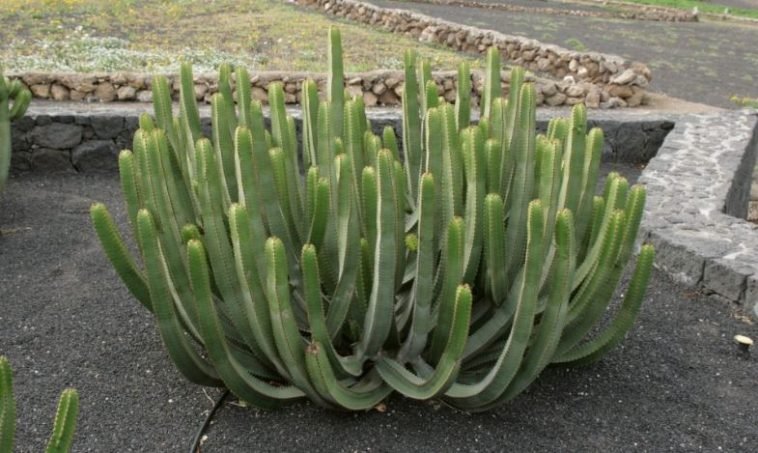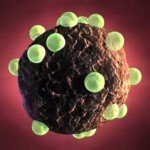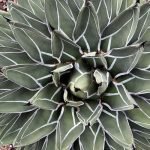Table of Contents
The location of Euphorbia Canariensis
The Euphorbia Canariensis or Canary Island spurge, is a species of phanerogam, (vascular plants that produce seeds ), of the family of the Euphorbiaceae .
This particular one is known as Canary Island spurge and has been chosen as a symbol of the Island of Gran Canaria.
Therefore, the Euphorbia canariensis is an endemism of the Canarian archipelago.
In Fuerteventura it is found naturally and due to the isolation of some areas, creating areas with large island spurges.
On the island of Lanzarote it is not present.
Characteristics of the Euphorbia Canariensis
It is a long-lived plant that can live more than 100 years, it is a perennial and succulent shrub, with the appearance of a cactus.
They are plant formations that occur in the low and dry areas of the islands.
It can reach up to 4 meters in height and cover 50 to 100 square meters of surface.
It grows creating extensive forms, which can gather up to several hundred clustered units forming circles from the main located in the center of the formation.
The Euphorbia Canariensis or Canary Island spurge, has succulent stems and leaves of light green color, that with the age they are turning into a grayish or silvery gray color.
Stems have a thickness of about 5 to 6 centimeters and have 5 edges, although you can see specimens with 4 or 6 edges.
Island spurge flowering occurs in spring and summer, with small unattractive brown flowers of reddish or brown color, that arise along their edges.
The seeds are encapsulated and released explosively.
The fruit, called trichoca, has a capsule shape with three reddish or brown valves.
How to care for Euphorbia Canariensis
Because of its growth habitat, it needs to grow in the sun or with some light shade.

It is good for all types of terrains that have a good drainage and in areas of warm environmental temperature.
It can be grown in rooms inside the houses, although it is not a typical domestic garden plant.
On warm winter days you can water it a little, no more than once or twice a month.
The Canariensis Euphorbia or Canary Island spurge, grows slowly and can become centennial.
It does not resist cold or frost, so starting at 7 to 8 degrees Celsius it starts to suffer. Below 0 / -2 degrees, it freezes.
What substrate to use for the Euphorbia Canariensis
The soil or substrate necessary to grow the Canariensis, will be a mixture of equal parts peat and sand.

If we grow the Euphorbia Canariensis or Canary Island surge in pots we can add a little garden soil.
Therefore, porous substrate with little organic matter (only a little mulch of leaves or peat).
How to water the Euphorbia Canariensis.
For irrigation, the needs of the Euphorbia Canariensis or Canary Island spurge, of water are somewhat greater than those mentioned for most cacti.
Water generously during active growth, that water does not accumulate in the roots.
The recipe can be, moderate watering every 5 days and reduce from the fall and remain in only one watering every 3 to 4 weeks in winter.
Excess water can rot the roots.

How to reproduce the Euphorbia Canariensis: Cuttings and seeds.
The Canary Island spurge, reproduces with some ease from seeds and by means of cuttings of healthy and vigorous plants.
In the case of reproduction by cutting, monitor the possible attacks of fungi.
How to prune the Euphorbia Canariensis.
Regarding the pruning of the Euphorbia Canariensis or Canary Island spurge, it is not necessary.
Just by removing the stems that are damaged or that grow undesirably for Island spurge formation, it is enough.
Maybe remove those stems needed to keep the plant beautiful and well developed.
Warning and proper uses of the Euphorbia Canariensis
Euphorbia Canariensis or Canary Island spurge, has a whitish and sticky latex, which is poisonous, if it is swallowed or comes in contact with the skin or mucous membranes.
This latex, improperly handled, can cause sneezing and may burn the skin.
It can cause fainting and cold sweats if used as a purgative.
In the field of veterinary medicine, it is used to cure the mumps of oxen.
The Guanches used Canary Island spurge latex, to poison the coastal water pools and collect the fish that remained as drugged










